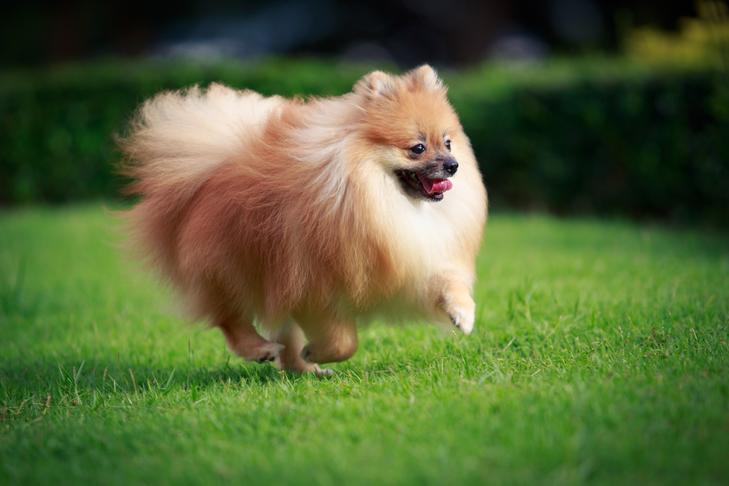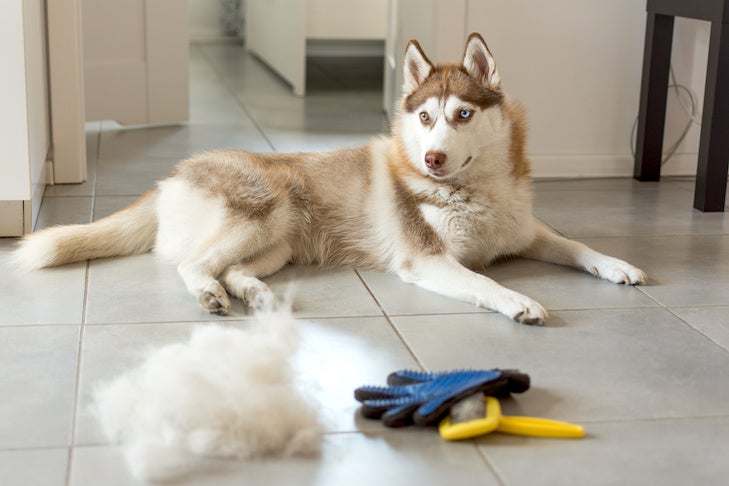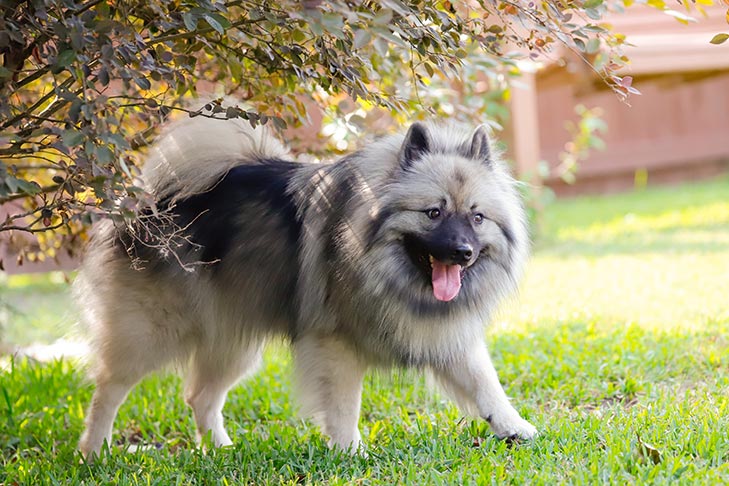Bald patches developing on your dog’s coat can be alarming and shouldn’t be ignored. However, alopecia — the medical name for hair loss — isn’t always a sign of something sinister.
In some cases, it can be a symptom of underlying causes, while in others, the issue is purely cosmetic (meaning it affects your dog’s appearance, rather than their internal health). If the luxurious coat of your plush-coated dog is becoming dull and sparse, but the dog appears otherwise happy and healthy, this symptom may relate to a condition known as alopecia X.
What Is Alopecia X in Dogs?
Alopecia X is a non-inflammatory form of hair loss in dogs that’s progressive (meaning it gets worse with time) and acquired (meaning it’s not hereditary). The good news is while your dog may look a little unusual, your pet usually won’t have to deal with red, itchy, or irritated skin (symptoms of the inflammatory forms of alopecia).
Your dog will typically have a regular coat before experiencing partial to complete hair loss occurs on specific body parts. Alopecia X can manifest in adult males and females at any age, but it usually appears in young adulthood.

Dr. Britt Levy, a board-certified veterinary dermatologist, says that a common way to describe alopecia X is Hair Cycle Arrest (HCA). This term relates to the fact that the coat’s normal cycles of shedding and growth are disrupted. According to board-certified veterinary dermatologist Dr. Matt Levinson, the condition has several other names, including black skin disease (referring to hyperpigmentation that may occur after hair loss) and sex hormone alopecia. You might even hear it called coat funk, wooly syndrome, or pseudo-Cushing’s. Pseudo-Cushing’s refers to the fact that hair loss is a symptom of both alopecia X and Cushing’s disease in dogs (which occurs when the body produces too much of the stress hormone cortisol).
Why Do Dogs Get Alopecia X?
Experts still don’t fully understand the exact cause of alopecia X. There have been many theories about why dogs develop the condition, but most have been disproven or studies are inconclusive. That’s why the condition is called alopecia X — it has symptoms similar to alopecia, but its exact cause is unknown.
However, certain breeds are associated with alopecia X. “The poster child is the Pomeranian,” Dr. Levy says. But she explains it is also common in spitz-type breeds from northern climates with plush double coats. This includes Alaskan Malamutes, Siberian Huskies, Keeshonds, Chow Chows, and Samoyeds. “It has been theorized that these breeds may have a higher likelihood of developing this condition due to their genetic predisposition to certain hormonal imbalances,” Dr. Levinson says.
Miniature Poodles and Toy Poodles can also suffer from alopecia X. However, because of the differences in coat types and hair follicles between the spitz-type breeds and Poodles, Dr. Levy explains that experts sometimes refer to alopecia X in Poodles as an alopecia X-like condition in Poodles.

Symptoms of Alopecia X in Dogs
It’s easy to overlook alopecia X in the beginning. It often develops gradually, and the first signs may simply be a dry, lackluster coat before progressing to symmetrical pattern hair loss.
To begin with, Dr. Levy explains, the condition usually affects the hind end or the back end before progressing. “It will not affect the head or lower aspects of the limbs, and the tail is variable,” she says. Some tails remain plush and fluffy, while other dogs lose hair on their tails (leading to what’s called a “rat tail”). A darkening of the exposed skin (hyperpigmentation) is also possible. Initially, your dog may only lose the top guard hairs, leaving a soft, puppy-like coat. “Some dogs may experience slow and steady hair loss over an extended period, while others may have more rapid progression,” Dr. Levinson says.
While the disease itself is painless, Dr. Levy explains that the exposed bald patches make dogs more vulnerable to skin infections or irritation. Occasionally, you might see scaling, greasiness, flakiness, or even pimples developing on the skin.
Diagnosing Alopecia X in Dogs
There is no specific diagnostic test to confirm your dog has the condition. “Diagnosis of alopecia X typically involves ruling out other potential causes of hair loss, such as infections, allergies, or thyroid issues,” Dr. Levinson says. He explains that hair loss related to alopecia X often resembles hair loss caused by non-inflammatory endocrine alopecia. Related to hormone levels, non-inflammatory endocrine alopecia occurs in dogs suffering from conditions such as Cushing’s disease, hypothyroidism, and sex hormone imbalances.
However, alopecia X and endocrine alopecia aren’t interchangeable. If your dog has endocrine alopecia, they’ll usually display other clinical signs, Dr. Levy explains. Cushing’s disease, for example, results in dogs drinking and eating more than usual, panting excessively, and acting lethargic. “Various tests, including bloodwork, hormone level assessments, skin biopsies, and possibly even adrenal function tests to rule out other causes are often performed to reach a definitive diagnosis,” Dr. Levinson says.

Dr. Levy says that veterinary dermatologists are seeing a rise in HCA in dogs exposed to certain human medications, including estrogen (to treat menopause symptoms) and strong topical steroids (to treat psoriasis). The initial hair loss symptoms look similar to alopecia X. However, even minimal exposure to these human drugs can cause serious illness in dogs. She advises that owners using these medications keep these products out of dogs’ reach and possibly discuss alternative medications with their physicians.
Treating Alopecia X in Dogs
Fortunately, treatment for alopecia X isn’t often necessary. It is a benign condition that doesn’t usually make your dog physically uncomfortable. Talk to your vet about whether or not treatment for alopecia X is the right choice for your dog.
Dr. Levinson points out that treatment responses can be highly variable among individual dogs. “Some may show significant improvement, while others may not respond to treatment at all,” he says. And there can be an initial positive response before the dog experiences further hair loss. Dr. Levinson says it is essential to work closely with a veterinarian (and maybe also a specialist experienced in treating the condition, such as a veterinary dermatologist) when considering any treatment options. They will help you develop and monitor an appropriate management plan for the individual dog.
Possible alopecia X treatments include hormonal therapies, microneedling, injections of platelet-rich plasma (which contains blood cells that help the body heal), and castrating intact male dogs. Because new hair growth often occurs at the site of trauma, you might consider microneedling. A veterinary dermatologist will use a dermaroller instrument to create microtrauma on the skin’s surface. This can stimulate the hair follicles to come out of the resting phase. However, Dr. Levy explains it is a painful procedure typically requiring sedation or general anesthesia. Talk to your vet about whether one of these treatments might be right for your dog.

Another treatment option is melatonin supplements, provided your dog doesn’t have diabetes. Dr. Levy explains that administering these oral hormones twice or three times daily has shown consistently positive results in around 30% to 40% of patients. However, not all supplements are created equal. It’s always good to opt for supplements made specifically for dogs. If your vet recommends melatonin for your dog, ask them which form of melatonin for dogs (whether liquid, tablets, or chews) would be best.
Management of Alopecia X in Dogs
Dr. Levy says having a good skincare regimen in place is important to manage alopecia X. This minimizes the chance of infections developing on the exposed skin. She recommends regular bathing with a gentle shampoo that balances the pH of your dog’s skin and hydrates. It’s important to make sure you’re feeding your dog a high-quality diet. You can also talk to your vet about whether you can add fatty acids (like fish oil supplements) to your dog’s food.
And for dogs with significant hair loss that spend a lot of time outdoors or sunbathing in windows, protecting them from excessive UV rays is beneficial. This is especially true if their skin has light coloring rather than dark hyperpigmentation. In warmer months, try a UV protective shirt for dogs or dog sunscreen (which can be beneficial all year). During colder months, a practical doggy coat or doggy sweater could be a worthwhile investment.
The post Alopecia X in Dogs: Signs, Symptoms, Treatment appeared first on American Kennel Club.



0 Comments
Recommended Comments
There are no comments to display.